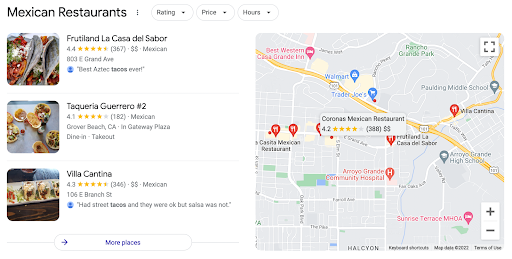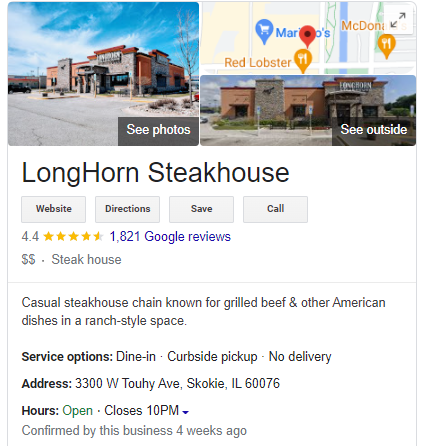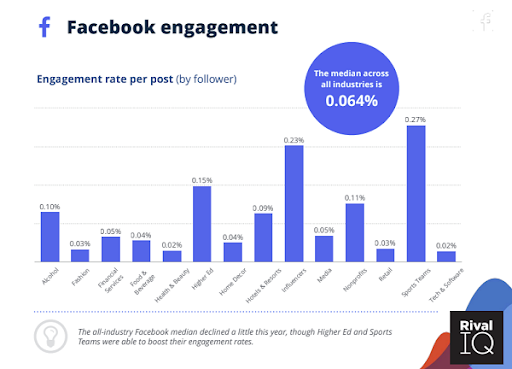Local Memo: Google Launches Interactive Local Pack Map

In this week’s update, learn about Google’s new interactive map; the return of appointment links; a “confirmed by the business” flag in Google profiles; the impact of Core Web Vitals in local search; keywords optimization in Google profiles; and benchmarks for brand engagement on social platforms.
Google Launches Interactive Local Pack Map
Google has introduced another local search update following the redesigned local pack that rolled out in December 2021. Both the new full-width local packs and the traditional kind are now displaying an interactive map, as covered in a post by Allie Margeson on the Whitespark blog. Google’s new interactive map replaces the static map that appeared previously. The new map adds a square “expand” icon on the top right that launches the local finder; a plus and minus icon on the lower right that provide zoom controls; the ability to scroll around in the map and change what is displayed in the viewport; and popups when hovering over a map pin that showcase the business name, rating, review count, and other select info such as average price for restaurants. Changing the map view does not alter which businesses are listed in the local pack, but does offer greater exposure for those who don’t make it into the top three, potentially leveling the playing field somewhat and giving lower-ranking businesses a stronger chance of getting noticed.
Search for “tacos near me” with popup in map showing a business not included in the local pack
Appointment Links Return to GBP
Appointment links have returned to Google Business Profiles, after reports of their widespread disappearance earlier this month. As you may recall, I speculated in this space that their removal might be the result of a bug, since appointment links were a popular feature and Google made no announcement about their sudden disappearance. According to information from Google, the removal was indeed unintended, though we don’t know anything specific about what happened behind the scenes. Several early reports indicated that, although the appointment feature had reappeared in most dashboards, updating the link content was still buggy or slow. Presumably this was just a symptom of the time it takes to roll out an update to all users; as of today, I’m able to update an appointment link in a profile and see it go live instantly. Most users should see the functionality return to normal very soon if it hasn’t happened already.Google Showing “Confirmed by This Business” in Profiles
Thibault Adda shared on Twitter that Google has added a notification underneath business hours indicating that the information has recently been confirmed by the business. In his example, the notification for the hours at a LongHorn Steakhouse reads, “Confirmed by this business 4 weeks ago.” The flag is similar to “Last updated” notices that sometimes appear next to hours and other business details, though the different wording here suggests that there’s a distinction. Perhaps “confirmed by this business” specifically means that Google users have suggested an update and the business has accepted it. Regardless, these flags show that Google wants users to know its information is up to date and accurate.
Image courtesy Thibault Adda
The Impact of Core Web Vitals on Local Search Performance
Google has just announced the rollout of the Page Experience update for desktop, meaning that the Core Web Vitals metrics applied to mobile search last year will now also be used to measure the performance of sites in a desktop search context. This update makes a new study from Whitespark especially timely. The study examines whether Core Web Vitals performance in local landing pages has an impact on local search ranking. To conduct the study, Whitespark ran Core Web Vitals analysis on the websites listed in 4,500 Google Business Profiles, and found that a great number of business websites perform poorly according to the new standard. Some 83% of the websites analyzed, for example, were determined to have content load speeds slower than is recommended by the new standards, with an average load time of 9.5 seconds for the largest content area on the page. The study found that poor performance in Core Web Vitals did not impact the ability of businesses to rank well in local search results; however, Google reports that bounce rate on mobile increases significantly as page load times get slower, with 53% of mobile page visits bouncing if the page takes more than 3 seconds to load. So for the moment, it appears that Page Experience doesn’t have much of an impact on rankings, but it could make the difference when it comes to conversion.Keyword Optimization in Google Profiles
Levi Williams-Clucas has an interesting post on the BrightLocal blog that looks at keyword optimization in Google Business Profiles. Keyword optimization is generally considered the province of onsite SEO, and it’s important to note that most experts agree you can’t rank better in local searches by adding keywords to your Google description, products, services, or any other areas that don’t fall within the narrow range of factors known to influence ranking (business name, keywords in reviews, primary and secondary category, etc.). However, the advice offered by Williams-Clucas makes sense from a conversion perspective. She suggests that adding keywords to your business description, Q&A, menus, posts, products, services, and elsewhere can help to boost the relevance of your listing in the minds of consumers, who may be searching for something specific and will want information reinforcing that your business is the right choice. For example, using keywords in posts increases the likelihood that a post-type justification will appear in a search result for a long-tail term, validating to the user that your business has what they’re looking for.Social Media Benchmarks for Brands
A new report from social media analytics firm Rival IQ looks at industry benchmarks for brands utilizing Facebook, Instagram, and Twitter. The report finds that engagement rates are falling on all three platforms, suggesting it is becoming more challenging for large brands to reach a broad audience. On Facebook, the average engagement rate – measured as a count of all engagements (reactions, comments, and shares) divided by the number of followers – was only 0.064%, compared to 0.09% in 2020 and 0.08% in 2021. As for post frequency, the median across all brands for Facebook was 5.87 posts per week. The Instagram engagement rate for brands was 0.67%, down from 0.98% in 2021 and 1.22% in 2020. Brands post on Instagram an average of 4.55 times per week. As for Twitter, engagement is down from 0.045% in 2020 to 0.037% today. Brands averaged 5 tweets per week according to the report. Increased competition for consumer attention is one probable reason for the decline in engagement. Brands can combat these trends by spending more on sponsored content and utilizing content favored by social platforms, such as short-form video. Note that the stats in the Rival IQ report relate to nationwide social media accounts for each brand, not individual store pages and profiles.
Subscribe to Local Memo!
Signup to receive Local memo updates and the latest on localized marketing, delivered weekly to your inbox.




